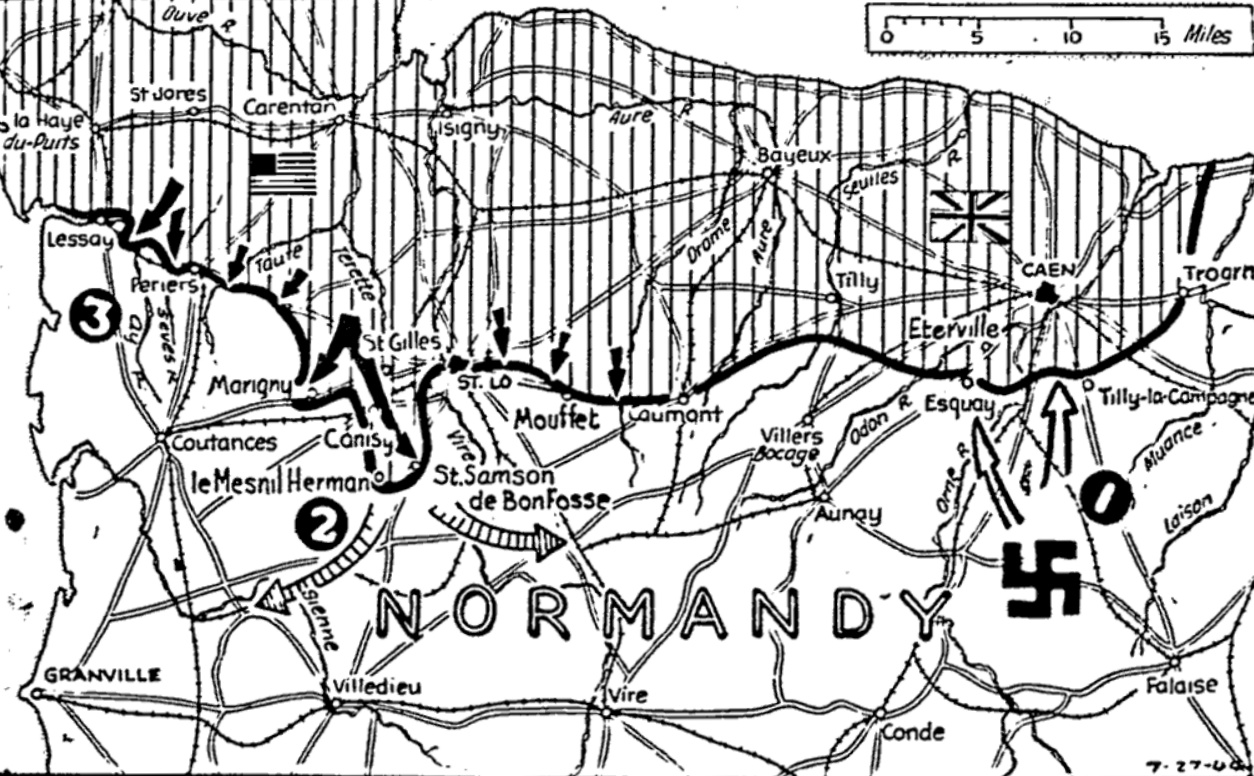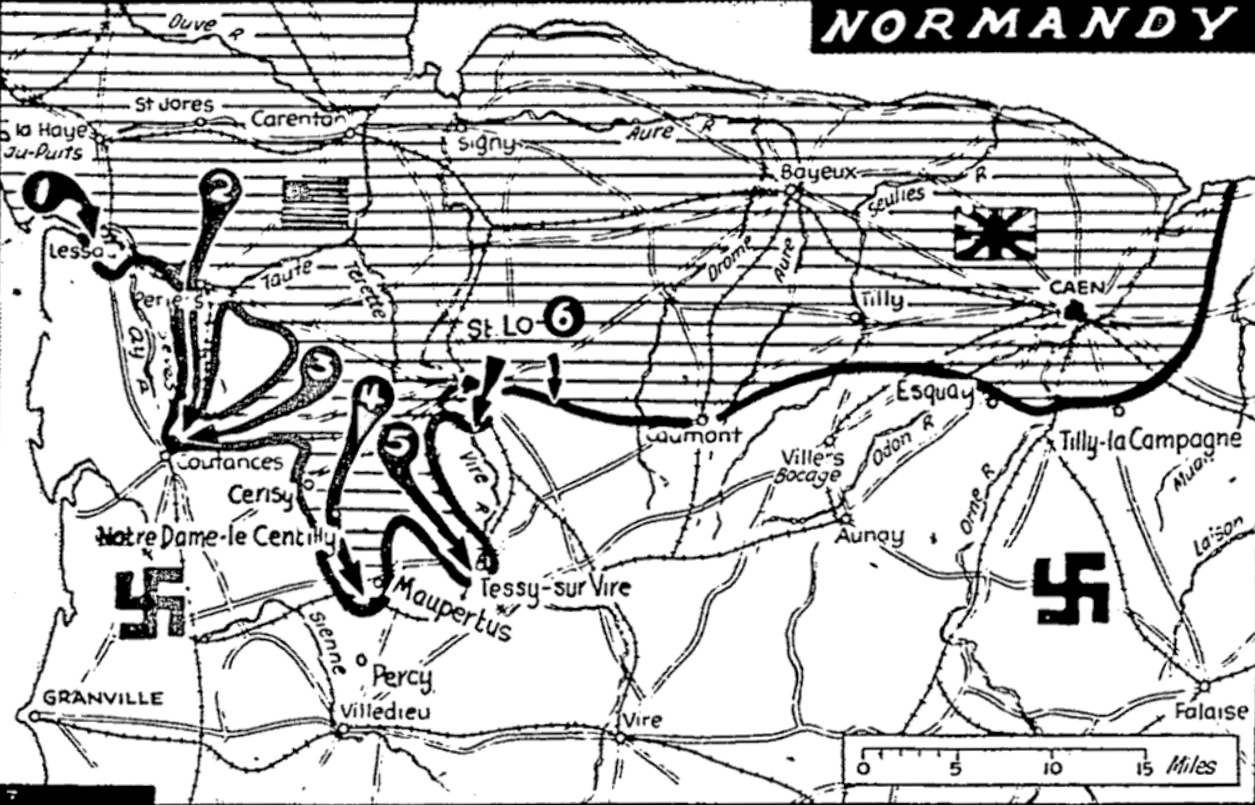Dr. Seibert: Weltbild aus Toronto und Lancashire
Von Kriegsberichter Dr. Seibert
Normandie, im Juli 1944 –
pk. Um die Gespräche, von denen hier berichtet wird, in ihrer ganzen Groteske würdigen zu können, muß der Leser versuchen, sich in das Milieu hineinzuversetzen, in dem sie geführt wurden: In die normannische Bauernlandschaft, in dieses ganz und gar europäische, ja fast heimatliche Stuck Erde, dessen Menschen uns näherstehen als die meisten anderen französischen Stämme, in diesen großen Obstgarten am Ärmelkanal, in dem so fleißig gearbeitet, gegessen und getrunken wird wie in irgendeinem Landstrich Mitteldeutschlands. In diese Dörfer, von deren Dächern nun der rote Hahn leuchtet, in deren heckenumstandenen Wiesen gefallenes Vieh verwest, erschlagen von englischen Bordkanonen, dessen bezaubernde Städtchen wüste Schutthaufen als Grabmäler Tausender friedlicher Männer, Frauen und Kinder tragen. In dieses Land, in das unsere Gegner eingebrochen sind wie die ägyptischen Plagen – ungerufen, unerwünscht, bar jeden Verständnisses für das, was den hier seit über tausend Jahren Siedelnden lieb und teuer ist.
Der erste, den wir trafen, gefolgt von dem jungen SS-Mann mit Gewehr unterm Arm, der ihn dreckstarrend aus einem Graben gezogen hatte, war ein Buchhalter aus Toronto. Misstrauisch bis in die Knochen, keck und ängstlich zugleich, erklärte er sofort, noch ehe wir den Mund auftaten, daß. er nichts „aussagen“ werde, was wir Wohl verstehen würden und im umgekehrten Falle doch auch nicht täten… Fünf Minuten später waren wir in einer hitzigen politischen Diskussion. Der Kanadier hatte rasch begriffen, daß uns seine militärischen Weisheiten, nicht interessierten, daß wir vielmehr nur wissen wollten, was in drei Teufels Namen er in diesem Lande zu suchen habe. Und darüber war er bereit, klare Auskunft zu geben: Es stellte sich heraus, daß er hier nicht etwa gelandet war, weil es ihm so befohlen war, sondern daß er allen Ernstes vorhatte, die Franzosen zu befreien. „So, so! Und hatten Sie den Eindruck, daß die in eurem Brückenkopf bereits Befreiten sehr glücklich darüber waren?“ Das gerade nicht, meinte Mr. W.; die Leute dort seien recht mürrisch gewesen und hätten „anscheinend“ unter der deutschen Besatzung nicht sehr gelitten.
Aber in anderen Gegenden Frankreichs, in der Pariser zum Beispiel, hätten wir ins ganz wüst aufgeführt…
„Woher wissen Sie denn das?“ Jawoll, antwortete er mit überlegener Miene, das wisse er ganz genau; die Briten hätten einen ganz ausgezeichneten Nachrichtendienst in ganz Europa. „Schön, mein Lieber, wenn das so ist, dann werden Sie sicher mit Vergnügen zusammen mit anderen Gefangenen durch Paris marschieren; wir wollen versuchen, Ihnen die Möglichkeit dazu zu verschaffen.“ Die Ironie ließ ihn die Ohren spitzen und die Frage stellen, wie das gemeint sei. Dann erzählten wir ihm, daß kürzlich anglo-amerikanische Gefangenentrupps auf dem Marsch von einem Pariser Bahnhof zu einem anderen von ganzen Scharen französischer Frauen schwer beschimpft und angespuckt worden seien – aus Dankbarkeit für die Befreiung in Form von wahllosem Terrorbombardement. Worauf Mr. W. sein unrasiertes Kinn kratzte, sich räusperte und schließlich die unverfängliche Frage stellte, ob wir nicht eine Zigarette hätten. Wir hatten eine.
Das war die Einleitung. Dann kam das übliche, das heißt die Wiederkäuung von rund zehn Jahren Roosevelt- und Churchill-Propaganda. Der Buchhalter aus Toronto verstand absolut nicht, warum die zehn Millionen Deutschen jenseits der Versailler Ostgrenzen des Reiches gerade unter deutscher Regierung leben wollten, und nicht unter tschechischer oder polnischer. Er verglich deren Lage allen Ernstes mit der Lage der Kanadier, die doch auch ganz gemütlich neben und außerhalb der USA lebten! Mr. W. war ganz sicher, daß die Polen „russische“ Herrschaft der deutschen vorzögen. Er hatte nie etwas davon gehört, daß die Esten, Letten und Litauer keinen Geschmack an der Sowjetverwaltung des Jahres 1940/41 gefunden hatten und sich mit Klauen und Zähnen gegen deren Wiederkehr wehrten. Selbst meine Hinweise auf teilweise recht offene Artikel der anglo-amerikanischen Presse zu diesem und verwandten Themen weckten kein Echo in seinem Hirn; „kann sein, daß die Zeitungsschreiber bei uns mal so was geschrieben haben, aber ich lese solches politisches Zeug nicht.“ Was er denn überhaupt über Europa gelesen habe und wisse? „Well, nicht sehr viel. Aber einer meiner Freunde ist vor dem Kriege im Schwarzwald gewesen; da muß es schön sein – kann man nicht dorthin in ein Gefangenenlager kommen?“ Da gab ich’s auf, aus diesem kanadischen Holzbock einen politischen Funken zu schlagen…
Wir waren inzwischen an einer Gefangenensammelstelle angelangt, und Buchhalter W. aus Toronto setzte sich zu seinen Genossen auf den Rasen. Sein Zigarettenrest wanderte von Mund zu Mund, jeder durfte einen Zug machen. An die 20 Burschen saßen da, alle zwischen 20 und 30 Jahren alt, US-Amerikaner. Als ich nähertrat, um dieses merkwürdige Sammelsurium von Typen zu betrachten, erhob sich ein baumlanger Mastersergeant, Hauptfeldwebel, und stellte sich ungefragt als der Rangälteste vor, die Hände in den Hosentaschen. „Ihr scheint schlechte Manieren in der US-Armee zu haben! Sprecht ihr mit euren Offizieren auch so?“ „Sorry, Sir,“ und die Hände kamen heraus.
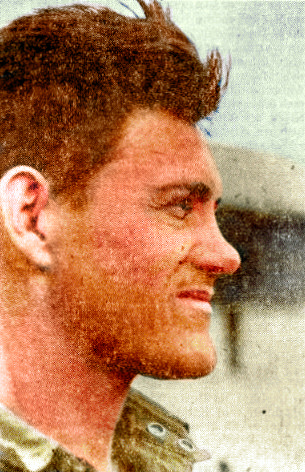
Amerikanischer Mastersergeant
Der erste, den wir ansprachen, war serbischer Abstammung. Ob er schon mal in Serbien gewesen sei? Natürlich nicht, und wo dieses Serbien genau war, wusste er auch nicht, „irgendwo auf dem Balkan, hat man mir gesagt.“ Der nächste, ein hämischer Bursch, bezeichnete sich als Holländer; ihm war versprochen worden, daß das Regiment in Holland landen würde, und nun war er böse, daß er zu den „damned French,“ zu den verdammten Franzosen geraten war. Mit Nr. 3, einem Mexikaner, war überhaupt nichts anzufangen, denn sein Englisch war schlimmer als chinesisches Pidgin-Englisch. Der vierte antwortete auf die Frage nach der Abstammung mit dem dunklen Wort „Eiteiljän;“ der Mastersergeant verbesserte in „Italian“ – nicht einmal richtig englisch aussprechen konnte Nr. 4 den Namen seiner Väter; Italienisch sprach er auch nicht. Der einzige Deutschblütige der Gruppe war ebenfalls keine Zierde seines Stammlandes; er wusste nicht einmal, aus welcher Gegend Deutschlands seine Großeltern herübergekommen waren. Dann kam ein biederer Schotte und schließlich ein Rassengemisch von einem Spaßvogel, der gleich „Irisch-Schottisch-Deutsch-Holländisch“ herunterschnurrte. Wie der Vollblutneger und der Indochinese in diese Musterkarte des „freiesten Volkes der Erde“ gekommen waren, vermochte nicht einmal der Mastersergeant anzugeben; sie schienen aus einem De-Gaulle-Regiment dazwischengeraten zu sein, Englisch oder Französisch sprachen beide nicht.
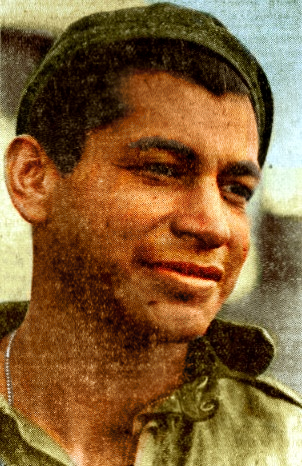
US-Gefangener mexikanischer Abstammung

US-Gefangener italienischer Abstammung (Aufn.: Atlantik)

Vollblutneger – ein besonders bemerkenswertes Exemplar von ‚Befreier Europas‘
Stumm besahen wir uns nochmals den ganzen Haufen, und allmählich stieg uns die Galle hoch. Jeder von diesen Soldaten Roosevelts mochte in seiner heimatlichen amerikanischen Umgebung irgendeinen Platz ausfüllen, irgendein persönliches Leben führen, irgendeinen obskuren Daseinszweck erfüllen. Alle waren sie, an europäischen Maßstäben gemessen, stumpf, uninteressant, primitiv, farblos: ein, vom Winde blinden Zufalls zusammengewehter Haufen artverschiedener Menschen, überzogen von der grauen Tünche einer Massenzivilisation. Und dieses rassische Strandgut aller Herren Länder wagte die ungeheuerliche Anmaßung eines Roosevelt als Befreier und Kulturbringer an das ehrwürdige Gestade Europas zu werfen, auf dem jeder Stein die Sprache der Geschichte sprach und jede Lebensart sich voll entwickelt hatte! Aber aus dem Zorn über solche Unverschämtheit wuchs die Bestätigung unserer Erkenntnis: Wenn man diese US-amerikanische Gefangenengruppe mit dem Erinnerungsbild jener braunen Sowjetscharen verglich, die man im Osten tausendfach gesehen hatte – war der Unterschied wirklich größer als ein bisschen höhere Zivilisation? War nicht hier wie dort die gleiche nationale Farblosigkeit, der gleiche Mangel an völkischem Gesicht und Wesen? Ist es mithin ein Wunder, daß die Bolschewisten kein zweites Volk so emsig nachahmend bewundern wie die Yankees, und daß die Yankees ihrerseits zwar den Bolschewismus als Antikapitalismus ablehnen, aber nicht den Abscheu aller europäischen Völker vor der Seelen- und Gestaltlosigkeit des östlichen Massenstaates teilen?
Mit diesen Gedanken im Sinn schlenderten wir zu einer Gruppe britischer Gefangener hinüber, die sich von ihren Bundesgenossen – hier wie überall in den Sammelstellen und Lagern – streng, wenn auch vielleicht absichtslos, absondern. Wir redeten einen Mann mit hoher Stirne und Hornbrille an, der sich als Maurer aus Lancashire entpuppte. Dem Photoapparat wich er geflissentlich aus. Warum? „Wenn mein Bild in die Zeitungen kommt, kann ich bei der Rückkehr Schwierigkeiten bekommen… Man hält mich dann vielleicht für einen ‚Collaborationist,‘ für einen, der mit den Deutschen zusammenarbeitet.“ Wir verzichteten gern auf sein belangloses Konterfei, worauf er gesprächig wurde. Sein Typ war bald klar: Er war der echte britische Kleinbürger, emsig bestrebt, nicht aufzufallen, sich der Standardmeinung anzuschließen, alle Schwenkungen der hohen und niederen Politik mitzumachen, „parteilos“ zu sein, ein trauriges Stück schaler Konvention. Er fand, daß die Konservativen „wieder im Kommen“ seien, fand aber auch, daß der sowjetische Kommunismus „viel Gutes“ habe, hoffte auf die Aera der zweiten Königin Elisabeth, weil es England unter Königinnen immer gut gegangen sei, versprach uns einen „milden“ Frieden und sich den „baldigen“ Sieg. Wusste nichts darauf zu sagen, als wir ihn an Churchills wilden Antibolschewismus vor 1941 erinnerten – Daß die Mehrzahl aller Briten von heutzutage solche traurigen Gesellen sind, die aus Mangel an Zivilcourage eifrig selbst die Scheuklappen festhalten, die ihnen das robuste Churchill-Regiment angelegt hat – das war ja die Voraussetzung für Churchills Krieg und ist die Grundbedingung für den Ausverkauf der britischen Weltmacht.
Wir ließen den Maurer stehen und wandten uns einem jungen Metallarbeiter zu. Er gehörte zur Labour-Partei, machte aber kein Hehl daraus, daß er diese für eine ziemlich vertrottelte Einrichtung hielt. Die Kommunisten? Nein, die „passten nicht“ für England. Die Kapitalisten? Mit denen gehe es zu Ende. Und dann? Nun, dann entwickelte der junge Mann in gesetzten, nachdenklichen Worten ein innenpolitisches Zukunftsprogramm seines Landes, das dem deutschen Nationalsozialismus glich wie ein Ei dem anderen! Als wir ihn schonend darauf aufmerksam machten, hielt er das zunächst für einen schlechten Witz, um in immer größeres Staunen zu geraten, als wir ihm an Hand nüchterner Tatsachen und Daten bewiesen, daß Deutschland den Weg, den er sich im Stillen für England erträumte, schon zu zwei Dritteln zurückgelegt hatte, als sein Churchill uns den Krieg erklärte. Und seine Überraschung wich der Bestürzung, nachdem wir ihm nicht minder nüchtern klargemacht hatten, daß weder Deutschland noch England die mindeste Aussicht auf die Verwirklichung des Sozialismus hätten, wenn die Sowjetheere je über die Grenzen Mitteleuropas hereinbranden sollten.
Der dritte Lancashire-Mann, Gasarbeiter seines Zeichens, war ein Pfiffikus, trotz seiner 21 Jahre. Er gehörte der Tory-Partei an und verschwor sich zuerst hoch und teuer, daß der prächtige Churchill uns einen wundervollen und braven Frieden schenken werde, wenn… Vor Stalin brauchten wir gar keine Angst zu haben, denn dem würde die Zunge zum Halse heraushängen am Ende der Schlachten, so daß Churchill – von Roosevelts Mitarbeit wollte der konservative Gasmann nicht viel wissen – Europa schön nach englischem Geschmack einrichten könne. Worauf wir ihn fragten, ob er etwas militärisch zu denken vermöge. Das wurde bescheiden, „im Rahmen der Möglichkeit eines einfachen Mannes bejaht.“ Gut, sagten wir, dann möge er einmal das Tempo und die Massenwucht der Sowjetoffensiven mit den anglo-amerikanischen Schneckenoffensiven vergleichen und daraus seine Schlüsse für den Fall eines deutschen Erlahmens ziehen… Das leuchtete ihm ein: „Ja, das wäre natürlich schlimm, wenn die Sowjets zuerst in Berlin ankämen.“ Und schließlich schloss er sich auch der Ansicht an, daß England in einer verflucht brenzligen Lage wäre, wenn dann erwartungsgemäß die roten Fahnen über ganz Europa hochgingen. Aber Churchill weiß das doch auch alles, und er wird schon wissen, wie er Stalin… „Betrügen kann?“ ergänzte ich. Seine stumm lächelnde Zustimmung versteinerte jedoch, als wir ihm an Churchills ganzer politischer Vergangenheit nachwiesen, daß sein Idol immer nur ein frecher Spieler gewesen war und heute nicht mehr aus der Sackgasse herauskönne, in die er Britannien hineingelotst hatte.
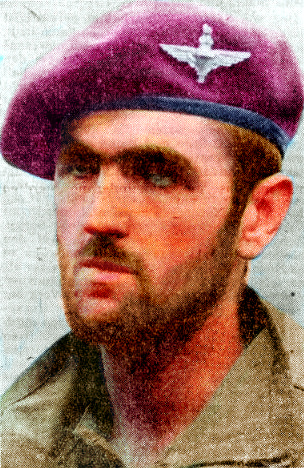
Gasarbeiter aus Lancashire
„Aber es muß doch eine Rettung für England geben!“ Es gibt keine Rettung für England, seit sein Volk schwach und gedankenlos genug war, sein Geschick einem Churchill anzuvertrauen. Und es wird ein grausames Erwachen für die Soldaten des großmäuligen Montgomery sein, die auf einen leichten Endsieg über die Deutschen und die Schlauheit des alten Fuchses in Westminster bauten…
